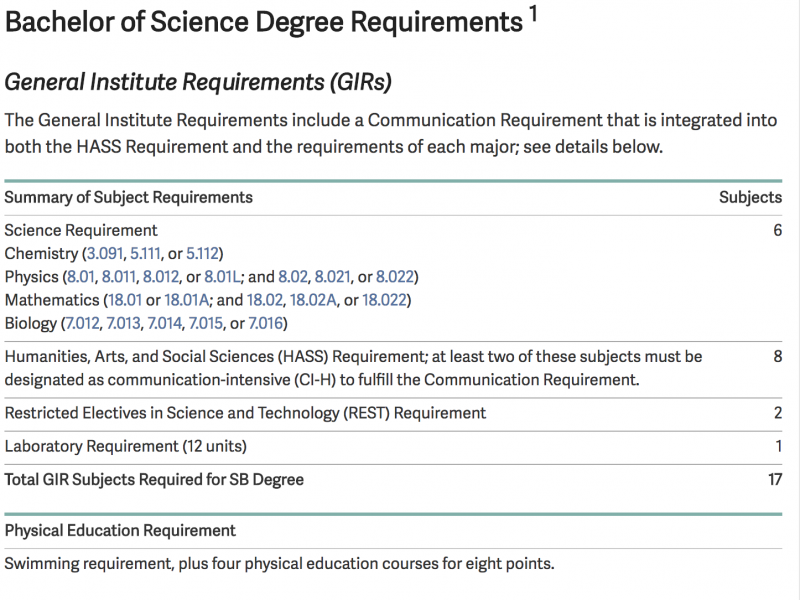Massachusetts Institute of Technology or MIT is consistently ranked among the top institutes for science and engineering. It prides itself in imparting a rigorous technical education to all students, regardless of their major field of study. With over 90 Nobel laureates, several named scholars and hundreds of influential entrepreneurs affiliated with it, MIT keeps churning out multifaceted talent. A significant portion of this education is delivered via MIT’s signature core curriculum–courses that are required of all undergraduate students.

(Source – catalog.mit.edu)
Since MIT focuses primarily on technology education, it should be no surprise that its core curriculum demands more science subjects than other institutions. There are a total of six required courses in science, including classical mechanics as well as electrodynamics in physics, single variable and multivariable calculus in mathematics and one course each in chemistry and biology. Fun fact: one of the introductory chemistry courses is taught by a Nobel laureate, and I took it in my very first semester of college.
With “Mens et Manus” (Mind and Hand) as MIT’s official motto, the school places a unique emphasis on hands-on implementation. This is reflected in a mandatory laboratory course, in any subject for which a considerable portion of the syllabus is dedicated to project work, building either a virtual or a physical device.
There’s something quite unexpected about the core curriculum, not apparent until you look closely. There are eight required courses in humanities, arts and social sciences (HASS). Many students (and their parents) are often shocked by this given MIT’s reputation as a hardcore technical college. There are, however, specific reasons for such requirements:
- Providing a well-rounded education: Inter-disciplinary knowledge is not only desired but required in the modern workplace. To be a well-integrated, functioning and productive member of society, it is necessary to have a working knowledge of a wide array of topics such as history, fine art, languages, economics or psychology as well having technical knowledge.
- Imparting better communication skills: About a decade ago, MIT alumni offered feedback that, although they had received an excellent technical education, they did not have the opportunity to develop the skills required to communicate their ideas effectively in the real world. Acting on that feedback, MIT has mandated communication coursework, taught through both the humanities subjects and technical areas.
The HASS requirements are implemented in a way that covers both breadth and depth. Every student is required to take at least one class each in social sciences, humanities, and arts. Furthermore, students are also expected to pick a concentration in one of the HASS subjects and complete three courses in that specific field. For instance, my HASS concentration is anthropology, a subject exploring the meaning of being human.
MIT’s core curriculum has been designed in a very MIT fashion–by iteration and revision, with its requirements evolving over decades, accounting for the ever-changing demands of work and life. Our core curriculum not only provides a rigorous foundation for technical majors but also incorporates humanities and arts while also weaving communication skills, resulting in students who are equipped to take on the world’s biggest challenges.
To know more about core curricula and other nuances of the US education system, get in touch with The Red Pen.
Ayush Sharma is a guest blogger for The Red Pen and studied computer science at the Massachusetts Institute of Technology. He is the founder and CEO of an early-stage startup that’s focused on stealth.




